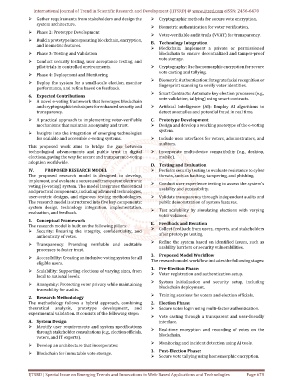Page 688 - Emerging Trends and Innovations in Web-Based Applications and Technologies
P. 688
International Journal of Trend in Scientific Research and Development (IJTSRD) @ www.ijtsrd.com eISSN: 2456-6470
Gather requirements from stakeholders and design the Cryptographic methods for secure vote encryption.
system architecture.
Biometric authentication for voter verification.
Phase 2: Prototype Development
Voter-verifiable audit trails (VVAT) for transparency.
Build a prototype incorporating blockchain, encryption, B. Technology Integration
and biometric features.
Blockchain: Implement a private or permissioned
Phase 3: Testing and Validation blockchain to ensure decentralized and tamper-proof
vote storage.
Conduct security testing, user acceptance testing, and
pilot trials in controlled environments. Cryptography: Use homomorphic encryption for secure
vote casting and tallying.
Phase 4: Deployment and Monitoring
Biometric Authentication: Integrate facial recognition or
Deploy the system for a small-scale election, monitor fingerprint scanning to verify voter identities.
performance, and refine based on feedback.
Smart Contracts: Automate key election processes (e.g.,
6. Expected Contributions
vote validation, tallying) using smart contracts.
A novel e-voting framework that leverages blockchain
and cryptographic techniques for enhanced security and Artificial Intelligence (AI): Employ AI algorithms to
transparency. detect anomalies and potential fraud in real time.
A practical approach to implementing voter-verifiable C. Prototype Development
mechanisms that maintain anonymity and trust. Design and develop a working prototype of the e-voting
system.
Insights into the integration of emerging technologies
for scalable and accessible e-voting systems. Include user interfaces for voters, administrators, and
auditors.
This proposed work aims to bridge the gap between
technological advancements and public trust in digital Incorporate multi-device compatibility (e.g., desktop,
elections, paving the way for secure and transparent e-voting mobile).
adoption worldwide.
D. Testing and Evaluation
IV. PROPOSED RESEARCH MODEL Perform security testing to evaluate resistance to cyber
The proposed research model is designed to develop, threats, such as hacking, tampering, and phishing.
implement, and evaluate a secure and transparent electronic
voting (e-voting) system. The model integrates theoretical Conduct user experience testing to assess the system’s
and practical components, including advanced technologies, usability and accessibility.
user-centric designs, and rigorous testing methodologies. Validate transparency through independent audits and
The research model is structured into five key components: public demonstration of system features.
system design, technology integration, implementation,
Test scalability by simulating elections with varying
evaluation, and feedback.
voter volumes.
1. Conceptual Framework
The research model is built on the following pillars: E. Feedback and Iteration
Security: Ensuring the integrity, confidentiality, and Collect feedback from users, experts, and stakeholders
authenticity of votes. after prototype testing.
Refine the system based on identified issues, such as
Transparency: Providing verifiable and auditable
usability barriers or security vulnerabilities.
processes to foster trust.
3. Proposed Model Workflow
Accessibility: Creating an inclusive voting system for all
The research model workflow includes the following stages:
eligible users.
1. Pre-Election Phase:
Scalability: Supporting elections of varying sizes, from
local to national levels. Voter registration and authentication setup.
System initialization and security setup, including
Anonymity: Protecting voter privacy while maintaining blockchain deployment.
traceability for audits.
Training sessions for voters and election officials.
2. Research Methodology
The methodology follows a hybrid approach, combining 2. Election Phase:
theoretical analysis, prototype development, and Secure voter login using multi-factor authentication.
experimental validation. It consists of the following steps:
Vote casting through a transparent and user-friendly
A. System Design interface.
Identify user requirements and system specifications
through stakeholder consultations (e.g., election officials, Real-time encryption and recording of votes on the
voters, and IT experts). blockchain.
Monitoring and incident detection using AI tools.
Develop an architecture that incorporates:
3. Post-Election Phase:
Blockchain for immutable vote storage.
Secure vote tallying using homomorphic encryption.
IJTSRD | Special Issue on Emerging Trends and Innovations in Web-Based Applications and Technologies Page 678

